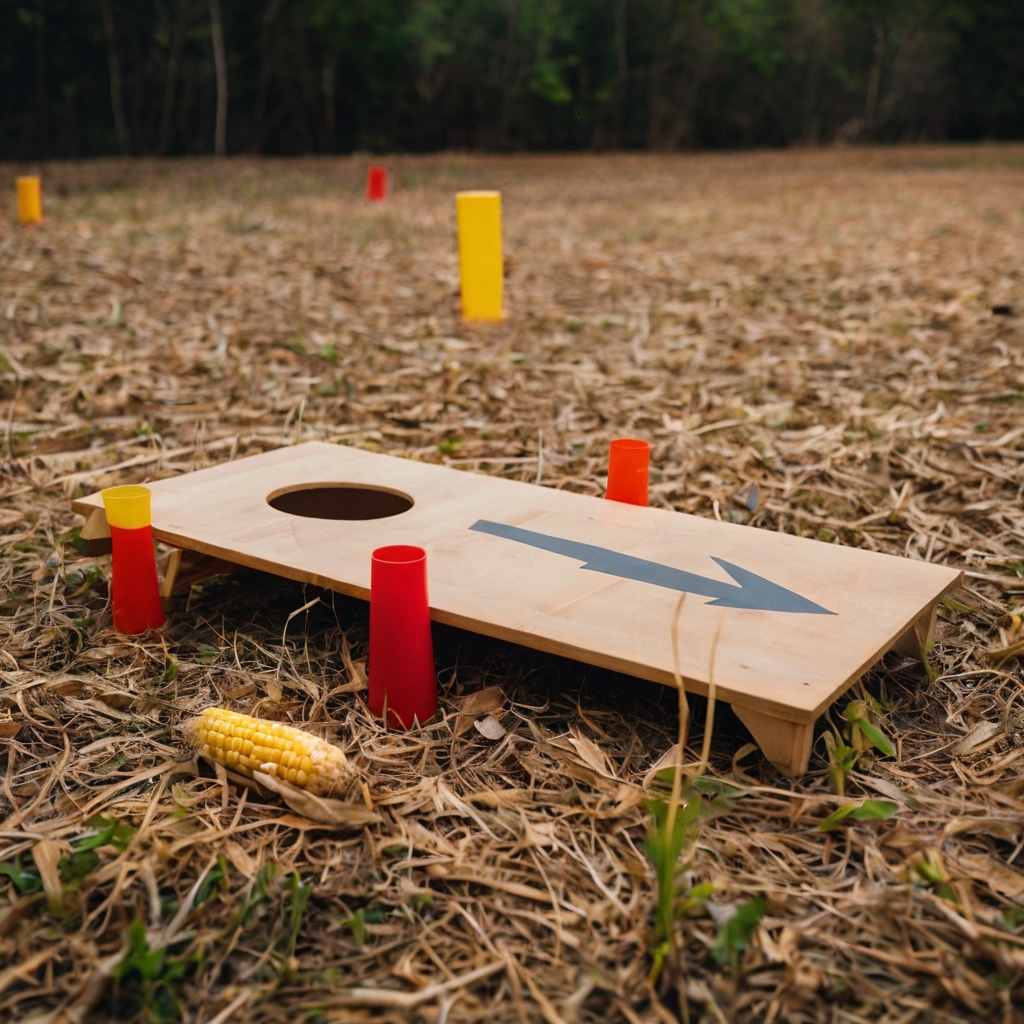Corn Hole Distances
The difference between casual backyard games and competitive success lies in professional cornhole distances. The American Cornhole Association mandates regulation cornhole courts to span 40 feet in length and 8 feet in width, with boards positioned exactly 27 feet apart.
Many players practice on incorrectly spaced setups that hurt their tournament performance and competitive edge. Adult players need the full 27-foot spacing, while junior players compete at a modified 21-foot distance. This piece gets into why proper cornhole distances matter, how they affect competitive play, and ways these measurements can create business opportunities in the growing cornhole industry.

The Financial Impact of Incorrect Cornhole Distances
Wrong cornhole distances create major financial problems that ripple through both casual players and serious competitors. Money problems go way beyond simple inconvenience and affect everything from how players practice to their success rates in tournaments.
How improper setup affects tournament preparation
Players practicing on wrongly spaced cornhole setups face big money losses when they enter competitions. Tournament venues need courts that measure exactly 8 feet wide and 40 feet long with boards placed 27 feet apart (front-to-front). Players who practice at wrong distances develop muscle memory that gets pricey during official competitions.
Teams usually pay around $40 to register for tournaments. This money goes to waste when players struggle because they can’t adjust to the right distance. Players who don’t adapt quickly to regulation distances get kicked out early – “Teams not at their bag court will be eliminated after 5 minutes”.
Tournament organizers face money problems too when distances aren’t right. They must tell players ahead of time if the vertical clearance is below the recommended 12 feet. Players who spent money to participate get upset when playing conditions aren’t proper, which can hurt future event earnings.
The cost of practicing on non-regulation setups
Practice on non-regulation setups starts a chain of expenses. Players spend lots of time learning techniques that don’t work at official distances. This leads to:
- Lost entry fees for tournaments they can’t win
- Missing out on cash prizes and awards
- Extra practice costs to fix bad habits
- Travel expenses to competitions where they perform badly
Casual players lose money too when they switch between informal and competitive play. Many players wrongly think distances can change – “If you are hosting a tournament between Uncle Jim and Cousin Sue, your boards can be as close or as far as you’d like”. This thinking causes expensive problems when they enter regulated play where exact measurements count.
Groups hosting fundraising tournaments lose money from wrong setups too. Cornhole fundraisers are “cost-efficient events” with “minimal upfront costs”, but they need proper execution to make money. Wrong distances make participants unhappy and hurt future turnout and donations.
Investment return on proper measurement tools
Good distance measurement tools are worth the money they cost. Several options exist in the market, including The Regulator, which is “The World’s First Attachable, Self-Retracting, Cornhole Measuring Device”. This tool takes “just one minute” to install and gives consistent 27-foot regulation distances.
The Quik-Toss measuring device needs “no installation” and comes “ready to go directly out of the package”. These tools cost money upfront but quickly pay off by:
- Saving time on manual measurements
- Creating practice conditions that match tournaments
- Making tournament entry fees worthwhile
- Boosting chances to win cash prizes and awards
- Making equipment last longer through proper setup
Professional competitors see this as a business expense that pays off. Tournament organizers save money on setup time and labor costs because “Your cornhole games will forever be consistent”.
Smart players know spending $40-60 on quality measurement tools protects their bigger investment in equipment, practice time, and tournament entries. This small expense pays off through better performance and more wins.
Official Regulation Distances Every Player Should Know
Knowing the right cornhole distances can set you apart from casual players in this popular sport. Professional play follows strict measurements, and mastering these specifications helps you win tournaments instead of struggling to adapt during competition.
American Cornhole Association standards
The American Cornhole Association (ACA) sets clear guidelines for official cornhole courts. A regulation court needs 8-10 feet in width and stretches 40-45 feet long. Players must place the boards exactly 27 feet apart, measured from front edge to front edge. This distance creates the perfect challenge for skilled players.
The ACA’s standards require each cornhole platform to measure 48 inches (1.22 m) long and 24 inches (61 cm) wide. The playing surface should lift between 12 and 15 inches (30 to 38 cm) at the back edge, while the front edge sits 2.5-3.5 inches from the ground.
Players should remember the foul lines during play. ACA rules state that “players must deliver the bag with an underhanded release” and “feet must stay behind the line of the front of the board at the time of releasing the bag”.
American Cornhole League variations
The American Cornhole League (ACL) follows similar standards to keep competitions consistent. The ACL requires exactly 27 feet between boards, allowing only a half-inch margin of error. The league also specifies approved wood types for official boards, such as birch or oak with a smooth finish.
The ACL adds rules about vertical space for tournaments: “A regulation size cornhole court is 8 feet wide and 40 feet long with a recommended vertical clearance of twelve (12) feet”. Tournament hosts must tell players beforehand if clearance falls below this standard.
Junior player accommodations
Both organizations adjust distances for younger players. Kids aged 12 and under should play with boards 12-15 feet apart. This shorter distance helps develop skills while keeping the game’s foundations intact.
The ACA states that “the junior-play foul lines shall be defined as an imaginary line 12-15 feet between the front of each board”. This creates a junior court about 20-23 feet (6-7 meters) long, which is by a lot shorter than the 35-foot adult court.
Casual vs. competitive play distances
Relaxed games can use different distances based on skill level and space. Players can “adjust the distance to make things a bit easier” for kids, seniors, and beginners. You should keep at least 12 feet between boards for any meaningful game.
Serious players know they need to practice at regulation distances. One expert says, “If you play it seriously, don’t gloss over official standards and spacing regulations”. Anyone wanting tournament success must practice at the 27-foot standard to build muscle memory and accuracy that works in competitions.
Dedicated players often buy proper measuring tools to ensure consistent practice conditions. This commitment to precise distances sets them apart from casual players who just enjoy the game for fun.
How Distance Errors Affect Your Throwing Strategy
The science of cornhole throwing shows how distance precision can make or break competitive success. Players who practice at wrong distances build muscle memory that doesn’t work in competition. This forces them to make tough adjustments under pressure.
Trajectory adjustments for different distances
The optimal trajectory forms the foundation of cornhole success at any distance. Players need a parabolic arc that lets bags land softly on the board from the regulation distance of 27 feet. A few feet shorter or longer means players need to adjust this fine-tuned trajectory right away.
Studies show experienced players develop consistent stance and throwing techniques specifically designed for regulation distances. Practice at incorrect distances creates muscle memory that players struggle to overcome during tournaments.
Release angles make a huge difference in how bags fly. Higher angles create more arch in the path, while lower angles make it flatter. Players need to find the perfect launch angle based on:
- Distance to the board (this matters most)
- Wind conditions and direction
- Personal throwing style preference
Players must change their entire throwing approach when they face non-regulation distances. “To achieve this trajectory, players must control the angle and force of their throw, taking into account factors such as wind and the bag’s weight”. These changes often cause timing problems during competitive play.
Power control variations
Distance variations don’t just affect trajectory – they also impact power control. Throwing too hard stands out as one of cornhole’s most common mistakes. Bags bounce off boards or fly past targets. This becomes even harder when players face unfamiliar distances.
Longer distances need enough force while keeping bags landing soft to avoid bounces. Shorter distances require less power without losing accuracy. This balance takes lots of practice to master.
Weather makes power management at different distances more complex. Wind affects trajectory and stability, so players adjust their throwing strength. Humidity changes how sticky bags feel and how they slide on boards.
Pro players develop specific throwing techniques for each distance. “Players must apply sufficient force to reach the board while ensuring the bag lands softly to minimize bouncing or sliding”. Finding the sweet spot between force and speed gets tricky when switching between distances.
Investing time in distance control practice pays off big in competition. Drills like “Distance Control Drill” and “Elevate Your Training” help players adapt to various distances. Players should:
- Master technique basics at shorter distances first
- Build power control by increasing distances slowly
- Use artificial obstacles to improve trajectory precision
- Add distance variation drills to regular training
Mastering cornhole distances through scientific throwing techniques goes beyond just improving form – it creates a real competitive edge. Players who can adapt faster between distances bring versatility that shows up in tournament wins and steady performance across all competitive conditions.
The Competitive Advantage of Mastering Multiple Distances
The Competitive Advantage of Mastering Multiple Distances
Players who excel at different cornhole distances stand out from average competitors in tournaments. Elite players adapt fast to varying distance conditions and have an edge over those who only practice at regulation measurements.
Adapting to tournament conditions
A player’s secret weapon in tournaments is flexibility. As one expert notes, “In cornhole, flexibility is your secret weapon”. The best players watch their opponents’ strategies and change their approach as needed. Some opponents might focus on blocking. Players who know how to throw from different distances can make precise airmail shots that get past these defensive strategies.
Board conditions change a lot between tournament venues. Players often face faster or slower surfaces that change how bags behave. This means they need to adjust their throwing distance. Experienced players show up early “to get some time on the boards to warm-up & test board conditions”. These practice sessions are a great way to get used to each venue’s specific cornhole distances and surface conditions.
Training techniques for distance flexibility
Players become more adaptable through structured distance-specific training. Here are the most effective training exercises:
- Distance Challenge Drill: “Work on your throwing distance by practicing different throws from varying distances. Start with a short distance, such as 10 feet, and aim to land the bags on the board or in the hole. Gradually increase the distance to 15, 20, or even 25 feet”.
- Elevation Training: “Practice throwing from different heights, such as an elevated platform or stairs. This exercise helps you adapt to varying conditions and angles you may encounter in different playing environments”.
- Obstacle Integration: “Create obstacles or barriers near the Cornhole board and practice throwing over or around them. This exercise hones your ability to adjust your trajectory and adapt to challenging scenarios”.
Weather conditions affect distance control by a lot. Wind speed and direction change bag flight patterns. Players must adjust their throwing power and angles right away. Players who practice in different conditions learn how to make these adjustments naturally.
Building versatility in your corn hole distances practice
Progressive overload principles help build distance mastery. “Gradually increase the difficulty of your practice sessions over time to challenge your muscles and continue improving”. This method develops the neural pathways needed for precise motor control at multiple distances.
Muscle memory plays a key role in distance versatility. Players who practice at different cornhole distances train their bodies to throw effectively in various settings. Technique matters, but repeating movements creates natural adaptability that helps during competition.
Static training falls short compared to adaptive practice that builds mental toughness. Players who “identify areas of their game that need improvement and dedicate focused practice time to them” become confident at multiple distances. This gives them a mental edge in high-pressure tournament situations.
Business Opportunities in Standardized Cornhole Setups
Business Opportunities in Standardized Cornhole Setups
Standardization of cornhole has opened up profitable business ventures for entrepreneurs who know proper setup requirements. The game’s popularity continues to grow nationwide. Proper corn hole distances have become a key market differentiator.
Rental services with proper measurements
Businesses that rent regulation-sized cornhole equipment can charge premium rates. A typical setup costs $40 per rental. Each package comes with two regulation boards (4 feet x 2 feet), eight weather-resistant bags, carrying cases, and rules documentation. Smart rental operations highlight proper measurements as their edge in the market.
Rental companies emphasize their commitment to official standards during peak seasons. They often state: “Our Cornhole Game adheres to official regulations, featuring the standard size and dimensions for professional cornhole play”. Companies like Party Perfect Event Rental have built regional rental empires in multiple states by focusing on measurement precision.
Tournament organization considerations
Tournament organizers can make money through several channels when they maintain proper corn hole distances. Local sponsors contribute $200-$2000 per event. Registration fees and concessions add to the revenue stream. Players’ satisfaction depends heavily on proper setup, so measurement accuracy remains crucial.
Tools like Scoreholio help streamline tournament operations before event day. These platforms handle scorekeeping and brackets efficiently. The choice between single and double elimination formats affects both player experience and venue needs. Profits can increase through “50/50 drawings” and “skills-based challenges.” Winners take 75-80% while organizers keep the rest.
Venue preparation for professional events
Smart venue selection gives organizers a competitive edge. The American Cornhole Association suggests indoor venues with ceilings at least 13 feet high. This height allows proper corn hole distances and eliminates weather concerns. Professional events need space for six indoor courts with optimal spacing.
Outdoor venues offer more flexibility but come with weather challenges that affect throwing distances. Professional venues must provide enough restrooms and refreshment options. Venue agreements spell out usage times, responsibilities, and penalties for early termination.
Entrepreneurs who focus on standardized corn hole distances set themselves up for better profits in this growing market. Precision measurement creates business opportunities in rental services, tournament organization, and venue management.
The life-blood of this faster growing sport lies in proper cornhole distances. Players who become skilled at regulation measurements have a clear edge in tournaments. Business owners who focus on standardized setups can create steady income through rentals, events, and professional venues.
Correct distances matter a lot to competitors and business owners alike. Players need to practice with regulation measurements consistently. Business owners can stand out by providing precise setups that meet professional standards.
Success in cornhole comes down to getting the details right, especially with distance specs. Players develop tournament-winning flexibility when they practice at different distances regularly. On top of that, business owners who get their measurements right grab a bigger slice of this growing market.
This game-changing sport keeps growing. It creates opportunities for competitive players and entrepreneurs who know their distance requirements. People who stick to regulation measurements will succeed. This applies to both practice sessions and professional events in this ever-changing sport.
Here are some FAQs about corn hole distances:
How far apart is Baggo?
Baggo uses the same standard cornhole distances as traditional cornhole, with boards placed 27 feet apart from front edge to front edge. This measurement follows official corn hole board distances used in professional tournaments and casual play alike. The consistent corn hole game distances ensure fair play whether you’re using Baggo brand boards or traditional cornhole boards.
Why is cornhole called cornhole?
The name “cornhole” comes from the original corn-filled bags used in the game that were tossed into the hole on the board. These corn hole distances between boards were established based on the optimal throwing range for these corn-filled bags. While modern bags often use plastic pellets, the corn hole rules and name have remained unchanged since the game’s agricultural origins.
How much do professional cornhole players make?
Top professional cornhole players can earn 50,000−50,000−100,000 annually through tournament winnings and sponsorships, with major events offering $10,000+ prizes. Players must master throwing at regulation corn hole distances on boards (27 feet) to compete at this level. The ACL (American Cornhole League) has helped standardize corn hole game distances and rules to grow the professional scene.
Can you go over 21 in cornhole?
Yes, you can score beyond 21 points in cornhole, but the game only ends when one team reaches or exceeds 21 at the conclusion of a round. This is one of the key corn hole rules that maintains fair play at all corn hole distances between boards. Teams must win by exactly 21 in some variations, while others allow any score over 21 to win.
What are cornhole bags filled with?
Modern cornhole bags are typically filled with plastic resin pellets, though traditional bags used dried corn kernels – hence the name. These bags must weigh between 15-16 ounces to meet official corn hole rules when thrown at standard corn hole board distances. The filler material affects how the bag slides and lands on the board at regulation corn hole distances.
How to win cornhole?
To win cornhole, you need to score exactly 21 points first by landing bags on the board (1 point) or in the hole (3 points) from the proper corn hole distances on boards. Mastering consistent underhand throws at the regulation how far should cornhole boards be apart distance (27 feet) is key to victory. Strategic play and blocking opponents’ shots are also important tactics in corn hole game distances competition.
Can you throw overhand in cornhole?
No, official corn hole rules require all throws to be underhand when playing at regulation corn hole distances between boards. The bag must be released below the waist when thrown from the standard corn hole board distances. This rule ensures fair play and maintains the game’s skill-based nature at all corn hole game distances.
What is called when the bag is thrown directly into the hole?
When a bag is thrown directly into the hole without touching the board first, it’s called a “swish” or “nothing but hole.” This scores 3 points according to corn hole rules, regardless of the corn hole distances between boards. Achieving consistent swishes at regulation how far should cornhole boards be apart distance (27 feet) is the mark of an expert player.
FOLLOW US ON FACEBOOK
RECENT POSTS
TAGS
About The Memory Hole
You've reached TheMemoryHole.org! A diverse lifestyle blog with content on a variety of different topics to help you define and live the life you want to live! Thanks for stopping by!
Copyright © The Memory Hole. All rights reserved.








